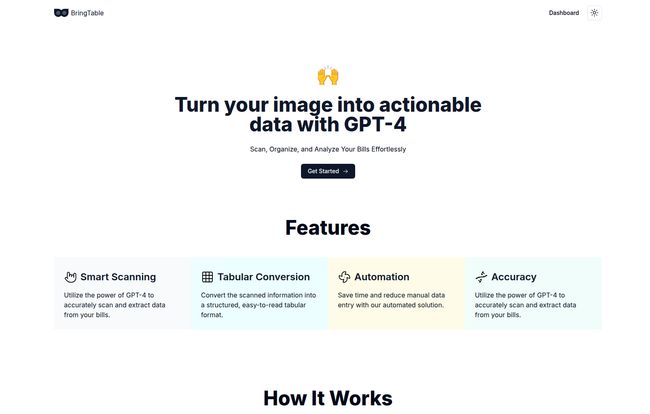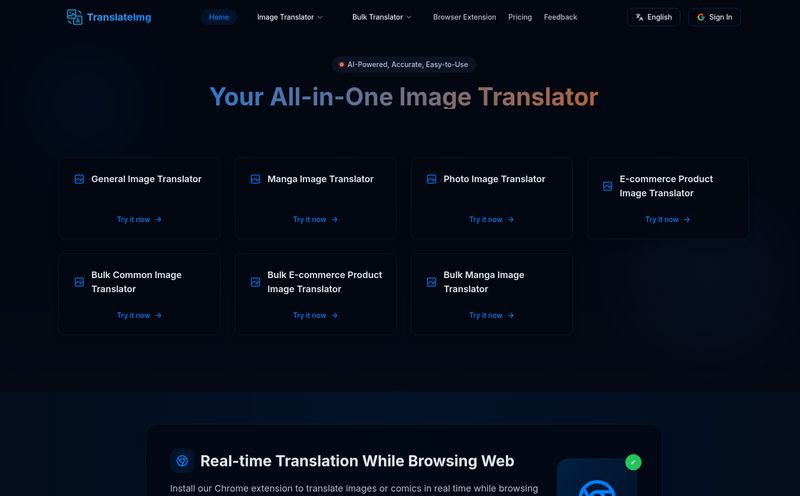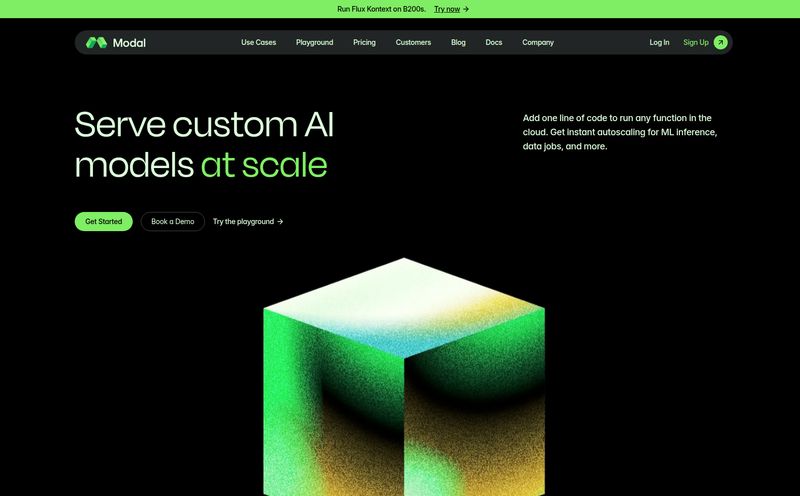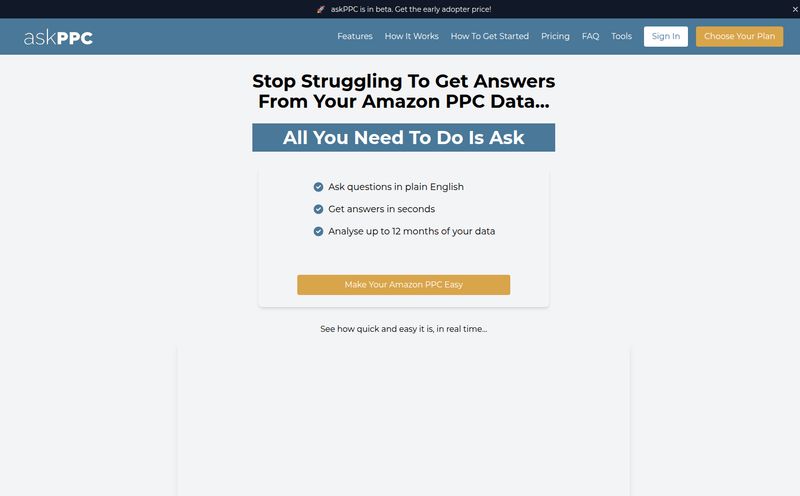If you're a freelancer, run a small business, or are just the 'organized one' in your family, you know the pain. That dreaded pile of receipts. It's a colorful, crinkled monument to your hard work, but it’s also a soul-crushing data entry project waiting to happen. I’ve spent more late nights than I care to admit, squinting at faded thermal paper and typing line items into a spreadsheet, all while questioning my life choices.
For years, the promise of technology was to save us from this. OCR (Optical Character Recognition) scanners helped, but they were often clumsy. They'd read a '5' as an 'S' or just completely miss a line item, leaving you to clean up the mess anyway. It felt like trading one chore for another.
So when I stumbled upon a new tool called BringTable, my inner tech geek and my overworked-accountant-self both sat up and paid attention. The headline was bold:
Turn your image into actionable data with GPT-4.
Okay, you have my attention. Could this actually be the solution we've been waiting for?
So, What Exactly is BringTable?
At its core, BringTable is deceptively simple. You give it an image of a bill or receipt, and it gives you back a neat, organized table of the data from that bill. Think of it like a magical translator that speaks fluent 'crumpled receipt' and translates it into perfect 'spreadsheet-ese'.
But the secret sauce isn’t magic, it’s GPT-4. Instead of just trying to recognize characters like old-school OCR, BringTable uses OpenAI's powerful model to understand the context of the document. It knows that "Total" is the final amount, that "QTY" means quantity, and it can intelligently pull out the item descriptions, prices, and taxes. This is a whole different ballgame.
It's designed to stop the manual grind. To take that stack of paper and turn it into something you can actually use—without the headache.
How The Magic Happens: A Quick Walkthrough
The process laid out on their site seems almost too easy, which always makes me a little suspicious. But its a simple idea, and I appreciate that. Here’s how it breaks down:
Step 1: You Set Up a Bill Template
This is the initial 'teaching' phase. You give it a sample of the kind of bill you want to process. This helps the system know what to look for. Are you scanning grocery receipts? Invoices from a specific supplier? Setting a template helps it zero in on the important stuff and ignore the fluff.
Step 2: Add Your Bill to Scan
This is the fun part. You upload your image. Snap a photo with your phone, scan a document, whatever you've got. The site says their "advanced GPT-4 model scans and analyzes the image." This is where the heavy lifting happens behind the scenes. You can almost imagine the little AI robots scurrying around, deciphering your coffee stain and figuring out how much you paid for that avocado toast.

Visit BringTable
Step 3: Get Your Beautiful, Tabular Output
And then… poof. Your data appears in a structured table. Clean rows and columns. No more manual typing. The information is extracted, organized, and ready to go. And, most importantly for anyone who actually needs to do something with this data, you can export it. The site specifically mentions exporting to CSV, which is the universal language of spreadsheets. Hallelujah.
The Features That Actually Matter
A lot of SaaS tools throw a bunch of features at you, but here’s what I think really counts with BringTable:
- Smart Scanning & Automation: These two are a pair. The scanning isn’t just smart because it uses GPT-4 for accuracy, it’s smart because it leads to genuine automation. The whole point is to eliminate a step in your workflow, and from the looks of it, this tool does exactly that.
- Tabular Conversion: Getting the text off a page is one thing. Putting it into a structured table is another. This is the difference between a tool that’s a novelty and a tool that’s a utility. Raw text is messy; a table is actionable.
- CSV Export: I can't stress this enough. A tool that locks your data in its own ecosystem is a data prison. The ability to export to CSV means you can pull your information into Excel, Google Sheets, QuickBooks, or whatever accounting software you use. It gives you freedom.
Let's Talk About the Fine Print: The Beta and The Price
Okay, let's get down to brass tacks. On their site, it clearly states:
We're in Beta. Try it for free!
For those not in the tech world, "Beta" means it's still a work in progress. There might be some bugs, the user interface might change, and some features might not be fully polished. It’s a public test flight. The upside? You get to use it for free and help shape its development. The downside? Don't bet your entire company's accounting on it just yet. It's a tool to augment your workflow, not completely replace your grizzled accountant, Bob.
I also noticed the API is listed as "Coming soon." For developers and businesses looking to integrate this technology directly into their own applications, this is huge. An API would let you pipe this functionality into your own expense reporting app or inventory system. Definitely one to watch.
As for pricing, right now, it appears to be free while in Beta. What will it cost later? Your guess is as good as mine, but SaaS tools in this space often have tiered pricing based on the number of scans per month. For now, free is a pretty great price.
Why This Isn't Just Another OCR Scanner
I mentioned this before, but it's worth repeating. I’ve used dozens of OCR tools. Some are fantastic for pulling text from a clean PDF. But point them at a messy, real-world receipt and they often fall apart.
Traditional OCR is like someone reading a book one letter at a time. It sees 'T-O-T-A-L' and spells out the word. GPT-4 is like someone who has read thousands of books and understands that the number next to the word 'TOTAL' is the most important figure on the page. It understands context and layout. It can differentiate between the date, the store name, the items, the tax, and the final amount, even if the layout is weird. That's a fundamental leap in capability, and it's why tools like BringTable are so dang promising.
FAQs About BringTable
1. Is BringTable really free to use?
Yes, for now! The platform is currently in a public Beta phase, which means they are offering it for free in exchange for user feedback. This might change once it officially launches, but it’s a great opportunity to test it out without any commitment.
2. What makes GPT-4 better for this than other scanners?
Traditional scanners use OCR to recognize characters. GPT-4 is a large language model that understands context, structure, and relationships within the data. This means it's much better at correctly identifying what each piece of information on a bill represents (e.g., this number is the tax, this one is the total) leading to far more accurate data extraction, especially from complex or inconsistent layouts.
3. Can I export my data from BringTable?
Absolutely. The platform supports exporting your extracted data into a CSV file. This is a universally compatible format that can be easily opened in Microsoft Excel, Google Sheets, Apple Numbers, or imported into most accounting software.
4. Is it safe to upload my bills and receipts?
While any online tool requires a degree of trust, BringTable provides links to their Terms of Service and Privacy Policy on their homepage. It's always a good practice to review these policies. Given it's built by developers (it's on Github), they likely follow standard security practices, but for highly sensitive financial documents, you should always exercise your own judgment.
5. Who is this tool best for?
It seems ideal for freelancers, small business owners, consultants, and anyone who needs to track expenses for reimbursement or tax purposes. Once the API is released, it will also be incredibly valuable for developers building financial or automation applications.
My Final Take: A Promising Glimpse of the Future
So, is BringTable the perfect, finished solution that will banish spreadsheets forever? Not yet. It's in Beta, and we have to see how it develops, what the final pricing looks like, and how robust it becomes.
But is it one of the most exciting, practical applications of advanced AI I’ve seen for a common, tedious problem? Absolutely.
This is the kind of AI I get excited about. Not the headline-grabbing stuff, but the quiet, practical tools that give us back our time and sanity. It’s a smart solution to a dumb problem, and I'm genuinely eager to see where it goes. If you're drowning in a sea of paper, I'd say it's well worth your time to give BringTable a try. You might just get your evenings back.
Reference and Sources
- BringTable Official Website: (I cannot link, but the main URL would be here)
- BringTable on Github: (The Github link from the image would be here)
- OpenAI's GPT-4 Information Page: https://openai.com/research/gpt-4



